Unveiling the Sensitivity Analysis of Port Carbon Footprint via Power Alternative Scenarios: A Deep Dive into the Valencia Port Case Study
Abstract
:1. Introduction
2. Materials and Methods
2.1. Literature Review
2.1.1. Theoretical Background in Sensitivity Analysis
2.1.2. Relevant Studies in Empirical Research: Renewable Energies in the Maritime Industry
- (i)
- Integration of hydrogen and renewable energy in marine applications: Gabbar et al. (2021) and Wang et al. (2023) delve into integrating nuclear–renewable hybrid energy systems and hydrogen-fueled ships, respectively. Gabbar et al. (2021) utilizes sensitivity analysis to evaluate various energy scenarios, aiming to reduce GHG emissions and optimize the energy mix for marine ships [23,24].Similarly, Wang et al. (2023) employ a life cycle assessment framework to quantify the environmental impact and economic feasibility of hydrogen-fueled ships, emphasizing sustainability and the reduction in the carbon footprint through renewable energy integration [24] Additionally, Berna-Escriche et al. (2023) focus on the potential of hydrogen as a renewable energy vector for marine applications. Sensitivity analysis is employed to assess the viability and impact of hydrogen integration on energy efficiency and carbon footprints [25].Thaler et al. (2023) optimize carbon capture and renewable energy systems in marine vessels, demonstrating the benefits of advanced renewable technologies like hydrogen through extensive sensitivity analysis [26]. Finally, Song et al. (2023) examines the maritime supply chains for emerging fuels such as hydrogen, ammonia, and methanol, comparing them to liquefied natural gas (LNG) [27].They conduct a sensitivity analysis on ambient temperature, storage time, and pipeline length. Their results show that methanol is the most energy-efficient when produced from renewable sources, followed by ammonia. Hydrogen, despite its potential, requires efficient boil-off gas handling systems to be competitive.
- (ii)
- Enhancing marine microgrids and offshore energy hubs: In maritime microgrids, Daraz (2023) offers an optimized cascaded controller that improves frequency stability. Sensitivity analysis provides consistent performance under changing load conditions, which is critical for the dependability of renewable energy systems in maritime applications [28].Meanwhile, Zhang et al. (2022) concentrate on modeling and assessing offshore energy hubs that incorporate a variety of renewable sources. Their sensitivity analysis reveals the best configurations and performance under various environmental and operational conditions, which is critical for developing clean offshore energy [29].
- (iii)
- Green strategies for ports and seaports: Integrating renewable energies in ports and seaports is a critical area of study. Vakili et al. (2022) benchmark fossil fuel reduction strategies in maritime logistics by utilizing sensitivity analysis to compare the effectiveness of various renewable energy technologies in reducing GHG emissions [30].Moreover, Gabbar et al. (2021) introduce nuclear–renewable hybrid energy systems (N-R HESs) as an effective solution for reducing GHG emissions in ocean-going ships. The study confirms the viability of N-R HESs as a cost-effective, reliable alternative for maritime energy, combining renewable energy with small-scale nuclear reactors [31]. Finally, Błażejewski T et al. (2021) demonstrate how a milk reusable packaging system using stainless-steel churns and glass bottles can significantly reduce CO2 emissions and resource depletion compared to single-use bottles. Sensitivity analysis underscores the robustness of these findings, revealing that recycling rates, water consumption for cleaning, reuse rates, and electricity sources critically influence environmental outcomes [32].
- (iv)
- Technological innovations and environmental sustainability: Chen et al. (2023) explore renewable energy solutions for marine applications using sensitivity analysis to evaluate the feasibility and benefits of integrating solar, wind, and hydrogen energy. Their research aims to enhance sustainability and reduce the carbon footprint of marine operations [33].Zhai et al. (2021) present a lifecycle assessment (LCA) of a wave energy converter, using sensitivity analysis to understand the uncertainties and impacts of various environmental factors on the lifecycle impact assessment results. Finally, the impact of control parameters in the DE algorithm is assessed using the Adaptive Differential Evolution (ADE) algorithm. A sensitivity analysis is carried out to assess the impact of different system parameters on this study’s findings [34].
- (v)
- Renewable methanol and onboard carbon capture: Thaler et al. (2023) investigate the use of synthetic fuels, particularly renewable methanol, in ship propulsion systems. They utilize a mixed-integer optimization framework and sensitivity analysis to evaluate the techno-economic performance of systems integrating onboard carbon-capture technologies. The results indicate significant cost advantages and emission reductions, demonstrating the potential for sustainable shipping solutions [26].
2.2. Methods
- A.
- Define the model and its inputs: Define the model and determine the critical input factors influencing its output. In this research case study, these input variables may be parameters, coefficients, or external elements that impact the model’s behavior, such as power generation or the use of renewable energies.
- B.
- Determine the range of values for each input variable: Determine the feasible range of values for each input variable. This range should represent the uncertainty or unpredictability of the input data and real-world situations, ranging from 0 to 100 percent of power generation by traditional resources, shown with generating electricity by renewables in this research study.
- C.
- Select a sensitivity analysis method: Based on the model’s properties and the research issue, choose an appropriate sensitivity analysis approach. Different methodologies have different strengths and weaknesses, and the context of the study determines the decision. This research project employs a model that can combine localized sensitivity analysis, variance-based methodology, and metamodel-based approaches, which will be discussed in the following sections.
- D.
- Perform the sensitivity analysis: Apply the selected model and its input variables. This might include running the model numerous times with varied input values or utilizing a computational tool to create random input situations.
- E.
- Analyze the results: Interpret the sensitivity study findings to identify the most crucial and feasible input variables, evaluate the model’s overall sensitivity, and analyze potential emission shares associated with uncertainty in input data.
- F.
- Draw conclusions: Based on the analysis findings, conclude the model’s robustness, suggest areas for additional exploration, and provide recommendations to improve the model’s dependability and applicability.
3. Sensitivity Analysis on the Case Study
3.1. Scenario “A”: Supplying the Whole Port’s Electrical Energy Needs with Renewables
| Emission Source | EF (kg CO2eq/kWh) | Fuel Cons (kWh) | Electricity Cons (kWh) | Emissions (Kg) | |
|---|---|---|---|---|---|
| SCOPE 1 | 160,599.46 | ||||
| SCOPE 2 | APV building lighting + power, APV roadway lighting, APV building: air conditioning system and other consumption | 0.2829 | - | 0 | 0 |
| SCOPE 3 | Commercial service-oriented electricity, service-oriented electricity, and other electricity | 0.282 | 0 | - | 0 |
| Other than electricity operation issues (Group A to commuters’ emissions) | 146,849,306.4 | ||||
| Total Emission | 147,009,905.86 | ||||
3.2. Scenario “B”: Supplying All Electricity Power in Scope 2 with Renewables
3.3. Scenario “C”: Supplying Half of the Entire Port’s Required Electricity from Renewables
3.4. Scenario “D”: Supplying 30% of the Entire Port’s Required Electricity from Renewables
4. Discussion
- Sensitivity: Scenario “A” is most sensitive to outside influences, followed by Scenario “C.” Scenario “D” is moderately sensitive, while Scenario “B” is least affected by changes.
- Emissions reduction share: Scenario “A” has the highest emissions reduction share. Scenario “C” has a slightly lower share, followed by Scenario “D.” Scenario “B” has the lowest emissions reduction share among the scenarios.
- -
- Scenario “A” with the amount of β = 16.5;
- -
- Scenario “B” with the amount of β = 0.793;
- -
- Scenario “C” with the amount of β = 3.747;
- -
- Scenario “D” with the amount of β = 2.052.
5. Conclusions
Author Contributions
Funding
Institutional Review Board Statement
Informed Consent Statement
Data Availability Statement
Acknowledgments
Conflicts of Interest
References
- Psaraftis, H.N.; Kontovas, C.A. Decarbonization of Maritime Transport: Is There Light at the End of the Tunnel? Sustainability 2020, 13, 237. [Google Scholar] [CrossRef]
- Makram, M.; Bassam, A.M.; Tawfik, A.A.; Yehia, W. Assessment of Onshore Renewable Energy Power Supply for Ship’s Emissions Reduction in Port Said West Port. J. Mar. Sci. Appl. 2024, 23, 506–524. [Google Scholar] [CrossRef]
- Lei, J.; Zhang, H.; Pan, J.; Zhuo, Y.; Chen, A.; Chen, W.; Yang, Z.; Feng, K.; Li, L.; Wang, B.; et al. Techno-Economic Assessment of a Full-Chain Hydrogen Production by Offshore Wind Power. Energies 2024, 17, 2447. [Google Scholar] [CrossRef]
- Zadeh, S.B.I.; Perez, M.D.E.; López-Gutiérrez, J.-S.; Fernández-Sánchez, G. Optimizing Smart Energy Infrastructure in Smart Ports: A Systematic Scoping Review of Carbon Footprint Reduction. J. Mar. Sci. Eng. 2023, 11, 1921. [Google Scholar] [CrossRef]
- Fang, S.; Wang, Y.; Gou, B.; Xu, Y. Toward Future Green Maritime Transportation: An Overview of Seaport Microgrids and All-Electric Ships. IEEE Trans. Veh. Technol. 2020, 69, 207–219. [Google Scholar] [CrossRef]
- Notteboom, T.; Haralambides, H. Seaports as green hydrogen hubs: Advances, opportunities and challenges in Europe. Marit. Econ. Logist. 2023, 25, 1–27. [Google Scholar] [CrossRef]
- Neumann, J.; da Rocha, R.C.; Debiagi, P.; Scholtissek, A.; Dammel, F.; Stephan, P.; Hasse, C. Techno-economic assessment of long-distance supply chains of energy carriers: Comparing hydrogen and iron for carbon-free electricity generation. Appl. Energy Combust. Sci. 2023, 14, 100128. [Google Scholar] [CrossRef]
- Zadeh, S.B.I.; Gutiérrez, J.S.L.; Esteban, M.D.; Fernández-Sánchez, G.; Garay-Rondero, C.L. Scope of the Literature on Efforts to Reduce the Carbon Footprint of Seaports. Sustainability 2023, 15, 8558. [Google Scholar] [CrossRef]
- UN Trade and Development Department. Maritime Transport 2015 Review, UNCTAD. 2015. Available online: https://unctad.org/webflyer/review-maritime-transport-2015 (accessed on 20 June 2024).
- Tang, D.; Jiang, T.; Xu, C.; Chen, Z.; Yuan, Y.; Zhao, W.; Guerrero, J.M. Assessing the Potential for Energy Efficiency Improvement through Cold Ironing: A Monte Carlo Analysis with Real Port Data. J. Mar. Sci. Eng. 2023, 11, 1780. [Google Scholar] [CrossRef]
- Kumar, N.; Panda, S.K. A Multipurpose and Power Quality Improved Electric Vessels Charging Station for the Seaports. IEEE Trans. Ind. Inform. 2023, 19, 3254–3261. [Google Scholar] [CrossRef]
- Tao, Y.; Qiu, J.; Lai, S.; Sun, X.; Zhao, J. Flexible Voyage Scheduling and Coordinated Energy Management Strategy of All-Electric Ships and Seaport Microgrid. IEEE Trans. Intell. Transp. Syst. 2023, 24, 3211–3222. [Google Scholar] [CrossRef]
- Misra, A.; Venkataramani, G.; Gowrishankar, S.; Ayyasam, E.; Ramalingam, V. Renewable Energy Based Smart Microgrids—A Pathway to Green Port Development. Strateg. Plan. Energy Environ. 2017, 37, 17–32. [Google Scholar] [CrossRef]
- Zadeh, S.B.I.; Soltani, H.R.; Ghoneim, N.I. Revamping Seaport Operations with Renewable Energy: A Sustainable Approach to Reducing Carbon Footprint. GMSARN Int. J. 2024, 18, 315–324. Available online: http://gmsarnjournal.com/home/wp-content/uploads/2023/12/vol18no3-4.pdf (accessed on 27 December 2023).
- Lazaroiu, C.; Roscia, M. The Sustainable port through sea wave energy converter. In Proceedings of the 2017 6th International Conference on Renewable Energy Research and Applications, ICRERA 2017, San Diego, CA, USA, 5–8 November 2017; pp. 462–467. [Google Scholar] [CrossRef]
- Tang, D.; Chai, Z.; Zhang, Q.; Yuan, Y.; Xu, W.; Gu, Y. Practice and Perspectives towards Sustainable Carbon Neutral Green Ports. In Proceedings of the 7th IEEE International Conference on Transportation Information and Safety, ICTIS 2023, Xi’an, China, 4–6 August 2023; pp. 13–18. [Google Scholar] [CrossRef]
- Heikkilä, M.; Saarni, J.; Saurama, A. Innovation in Smart Ports: Future Directions of Digitalization in Container Ports. J. Mar. Sci. Eng. 2022, 10, 1925. [Google Scholar] [CrossRef]
- Zadeh, S.B.I. Environmental Benefits of Reducing Greenhouse Gas Emissions from Smart Ports via Implementation of Smart Energy Infrastructure. GMSARN Int. J. 2024, 18, 431–439. Available online: https://gmsarnjournal.com/home/wpcontent/uploads/2024/03/vol18no4-3.pdf (accessed on 20 March 2024).
- Saltelli, A.; Tarantola, S.; Campolongo, F.; Ratto, M. Sensitivity Analysis in Practice: A Guide to Assessing Scientific Models; John Wiley & Sons, Ltd : Hoboken, NJ, USA, 2002. [Google Scholar]
- Le Gratiet, L.; Marelli, S.; Sudret, B. Metamodel-Based Sensitivity Analysis: Polynomial Chaos Expansions and Gaussian Processes. In Handbook of Uncertainty Quantification; Springer International Publishing: Berlin/Heidelberg, Germany, 2015; pp. 1–37. [Google Scholar] [CrossRef]
- Borgonovo, E. Sensitivity Analysis; Springer Nature: Dordrecht, The Netherlands, 2017; Volume 251. [Google Scholar] [CrossRef]
- Razavi, S.; Gupta, H.V. What do we mean by sensitivity analysis? the need for comprehensive characterization of ‘global’ sensitivity in Earth and Environmental systems models. Water Resour. Res. 2015, 51, 3070–3092. [Google Scholar] [CrossRef]
- Gabbar, H.A.; Adham, M.I.; Abdussami, M.R. Analysis of nuclear-renewable hybrid energy system for marine ships. Energy Rep. 2021, 7, 2398–2417. [Google Scholar] [CrossRef]
- Wang, Z.; Zhao, F.; Dong, B.; Wang, D.; Ji, Y.; Cai, W.; Han, F. Life cycle framework construction and quantitative assessment for the hydrogen fuelled ships: A case study. Ocean Eng. 2023, 281, 114740. [Google Scholar] [CrossRef]
- Berna-Escriche, C.; Rivera-Durán, Y.; Córdova-Chávez, Y.; Muñoz-Cobo, J.L. Maximizing the use of hydrogen as energy vector to cover the final energy demand for stand-alone systems, application and sensitivity analysis for the Canary Archipelago by 2040. Prog. Nucl. Energy 2023, 163, 104791. [Google Scholar] [CrossRef]
- Thaler, B.; Kanchiralla, F.M.; Posch, S.; Pirker, G.; Wimmer, A.; Brynolf, S.; Wermuth, N. Optimal design and operation of maritime energy systems based on renewable methanol and closed carbon cycles. Energy Convers. Manag. 2022, 269, 116064. [Google Scholar] [CrossRef]
- Song, Q.; Tinoco, R.R.; Yang, H.; Yang, Q.; Jiang, H.; Chen, Y.; Chen, H. A comparative study on energy efficiency of the maritime supply chains for liquefied hydrogen, ammonia, methanol and natural gas. Carbon Capture Sci. Technol. 2022, 4, 100056. [Google Scholar] [CrossRef]
- Daraz, A. Optimized cascaded controller for frequency stabilization of marine microgrid system. Appl. Energy 2023, 350, 121774. [Google Scholar] [CrossRef]
- Zhang, H.; Tomasgard, A.; Knudsen, B.R.; Svendsen, H.G.; Bakker, S.J.; Grossmann, I.E. Modelling and analysis of offshore energy hubs. Energy 2022, 261, 125219. [Google Scholar] [CrossRef]
- Vakili, S.; Schönborn, A.; Ölçer, A.I. Techno-economic feasibility of photovoltaic, wind and hybrid electrification systems for stand-alone and grid-connected shipyard electrification in Italy. J. Clean. Prod. 2022, 366, 132945. [Google Scholar] [CrossRef]
- Gabbar, H.A.; Adham, M.I.; Abdussami, M.R. Optimal Planning of Integrated Nuclear-Renewable Energy System for Marine Ships Using Artificial Intelligence Algorithm. Energies 2021, 14, 3188. [Google Scholar] [CrossRef]
- Błażejewski, T.; Walker, S.R.; Muazu, R.I.; Rothman, R.H. Reimagining the milk supply chain: Reusable vessels for bulk delivery. Sustain. Prod. Consum. 2021, 27, 1030–1046. [Google Scholar] [CrossRef]
- Chen, L.J.; Zhang, L.; Kung, C.C. An economic analysis on Taiwanese wind power and regional development. Energy Explor. Exploit. 2020, 38, 1228–1247. [Google Scholar] [CrossRef]
- Zhai, Q.; Li, T.; Liu, Y. Life cycle assessment of a wave energy converter: Uncertainties and sensitivities. J. Clean. Prod. 2021, 298, 126719. [Google Scholar] [CrossRef]
- Zadeh, S.B.I.; Gutiérrez, J.S.L.; Esteban, M.D.; Fernández-Sánchez, G.; Garay-Rondero, C.L. A Framework for Accurate Carbon Footprint Calculation in Seaports: Methodology Proposal. J. Mar. Sci. Eng. 2023, 11, 1007. [Google Scholar] [CrossRef]
- Authoridad Puertaria de Valencia. Statistical Report Port Authority of Valencia 2023. 2023. Available online: https://www.valenciaport.com/wp-content/uploads/2312-Statistical-Report-December-2023_Definitivo.pdf (accessed on 21 July 2024).
- Port Authority of Valencia. GHG Emissions Report of the APV, 2016. 2018. Available online: https://www.valenciaport.com/wp-content/uploads/Memoria-Verificaci%C3%B3n-GEI-2016.pdf (accessed on 27 April 2023).
- Valencia Port Authority. Statistical Yearbook 2016. 2018. Available online: https://www.valenciaport.com/wp-content/uploads/Anuario_estadistico_2016_APV_ENG.pdf (accessed on 20 June 2024).
- de E. Puertos del Estado, G. Methodological Guide for the Calculation of the Carbon Footprint in Ports. 2020. Available online: https://www.puertos.es/es-es/medioambiente/Documents/Guia%20Huella%20de%20Carbono%20-%20Puertos%20del%20Estado%20-%20Web.pdf (accessed on 23 July 2024).
- Fundación Valencia Port. EALING–European Flagship Action for Cold Ironing in Ports. Available online: https://www.fundacion.valenciaport.com/en/project/ealing-european-flagship-action-for-cold-ironing-in-ports/ (accessed on 21 July 2024).
- Valencia Port Authority. Statistical Report APV. 2021. Available online: https://www.valenciaport.com/wp-content/uploads/APV-Environmental-Declaration-2021.pdf (accessed on 20 June 2024).
- International Energy Agency. Renewables 2023 (Analysis and Forecast to 2028). Available online: www.iea.org (accessed on 20 June 2024).
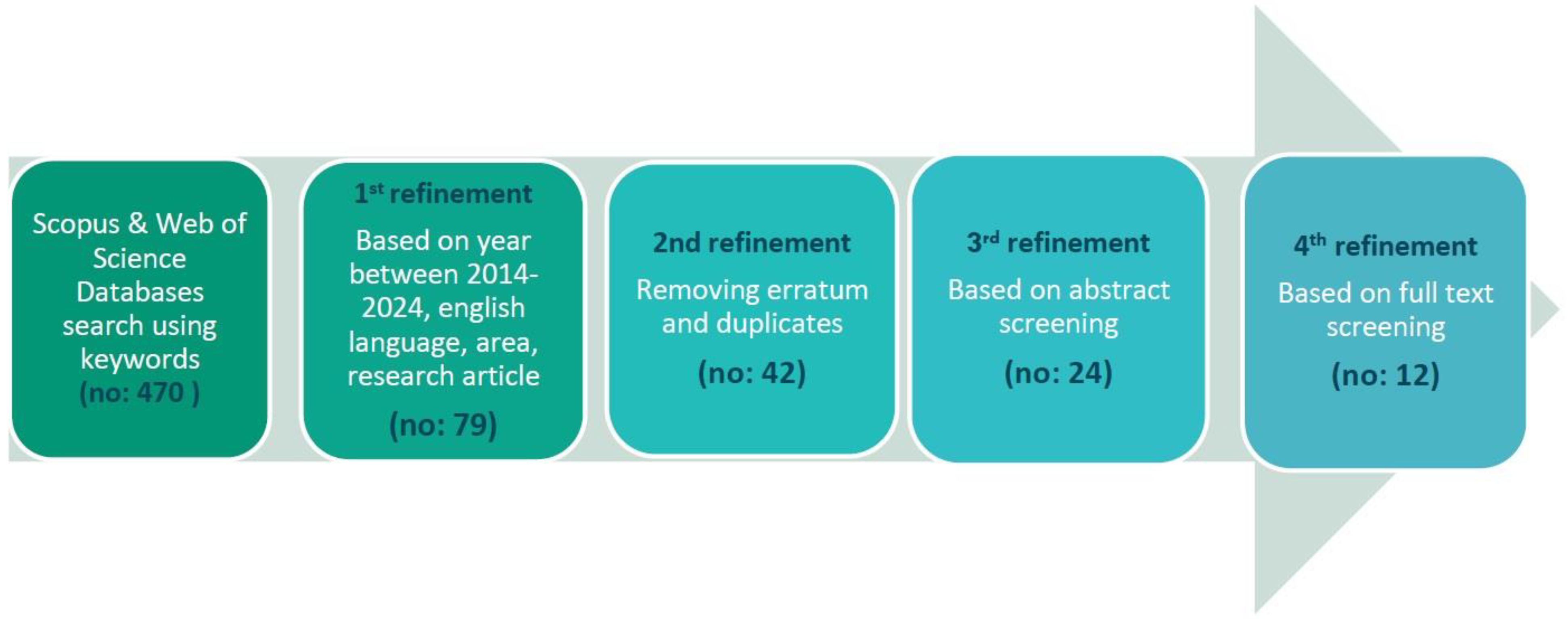
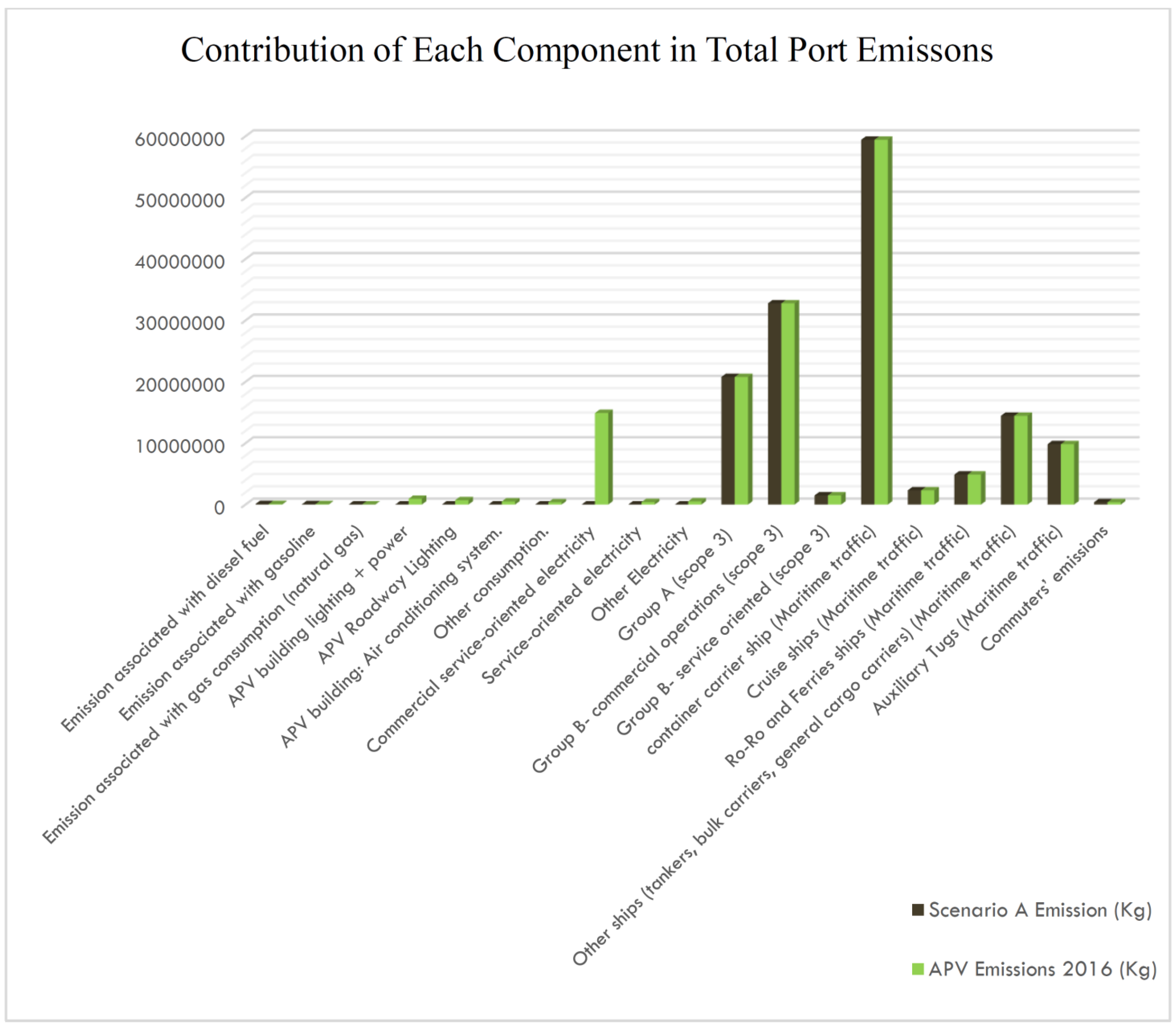
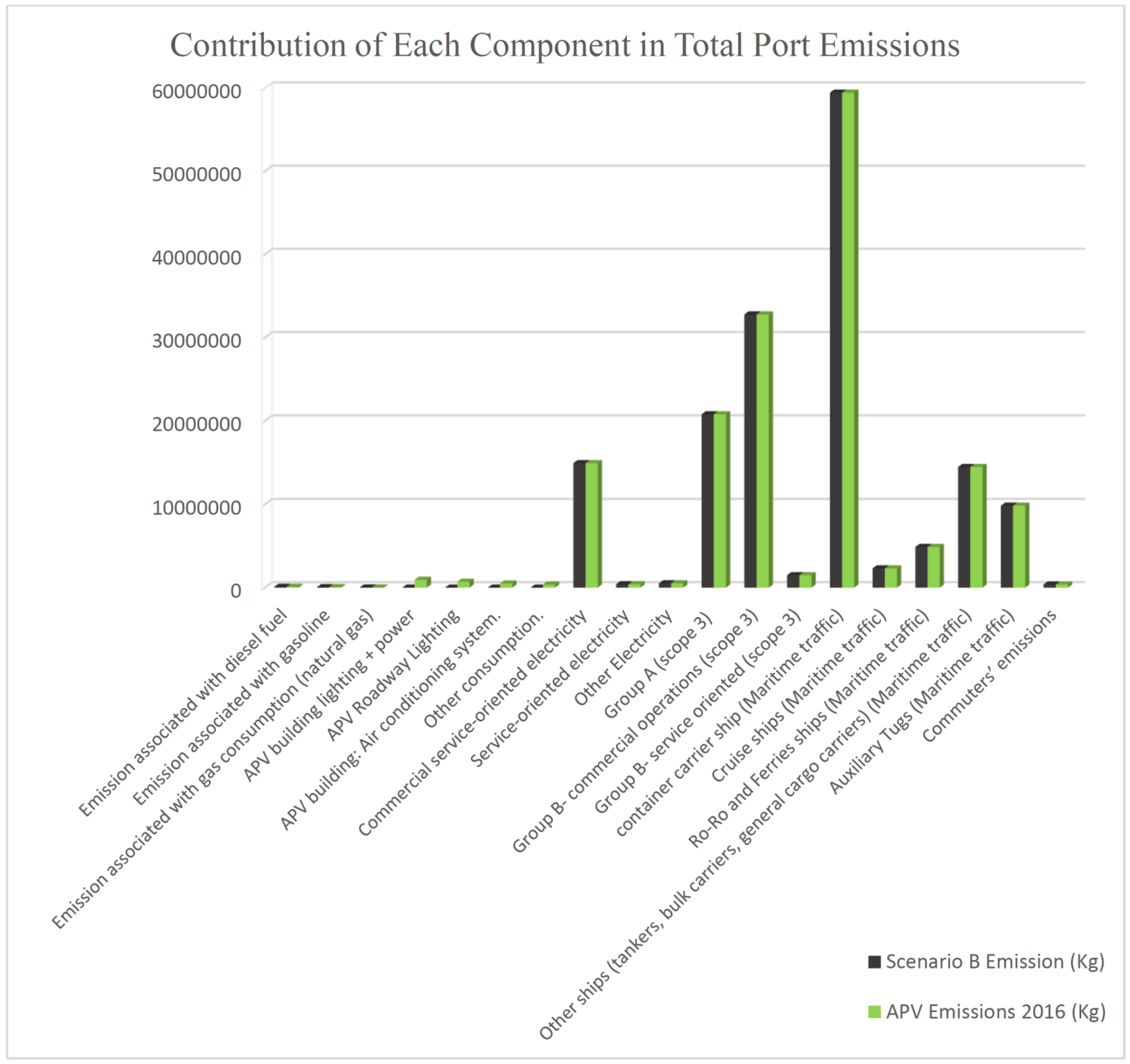
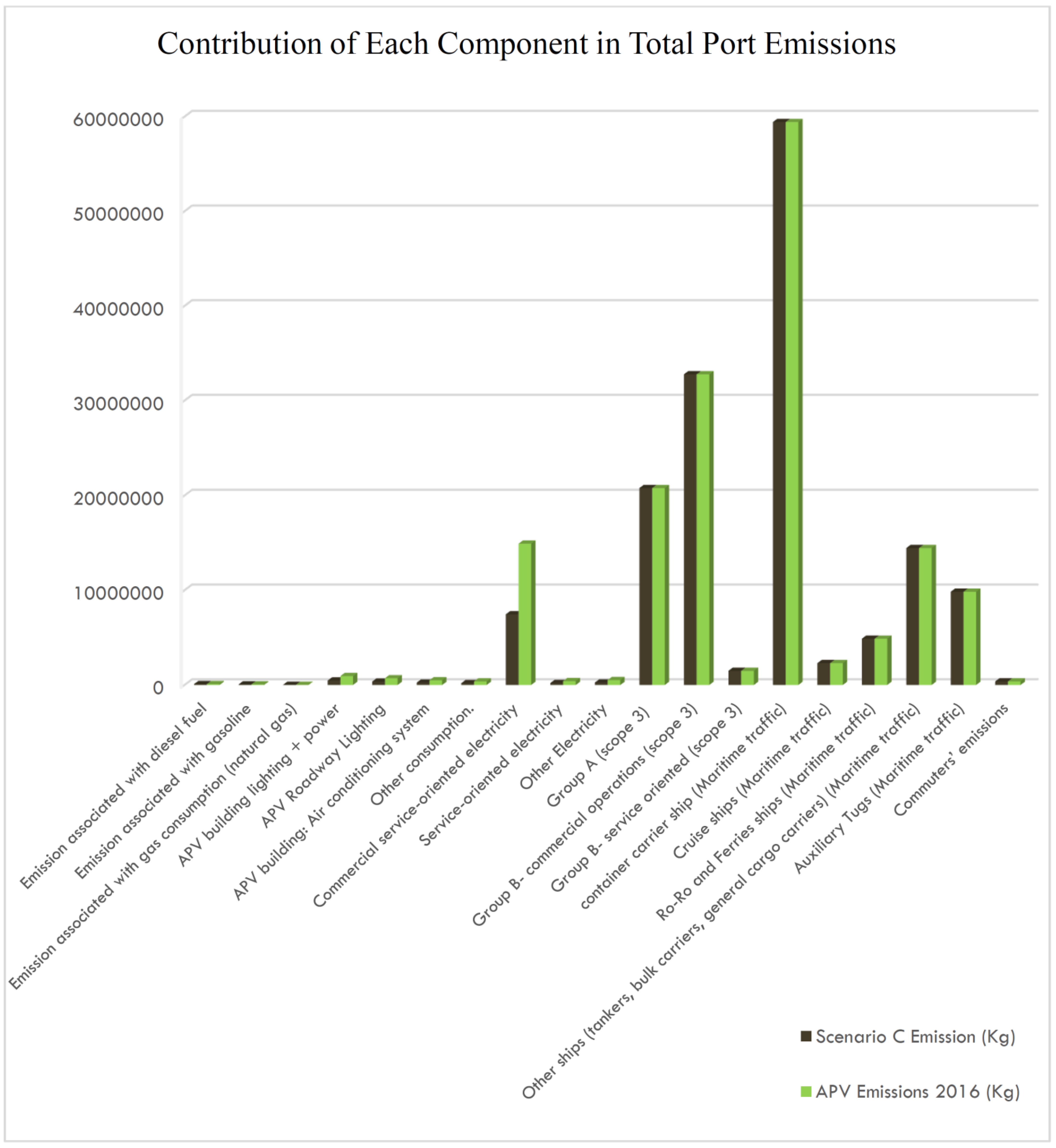

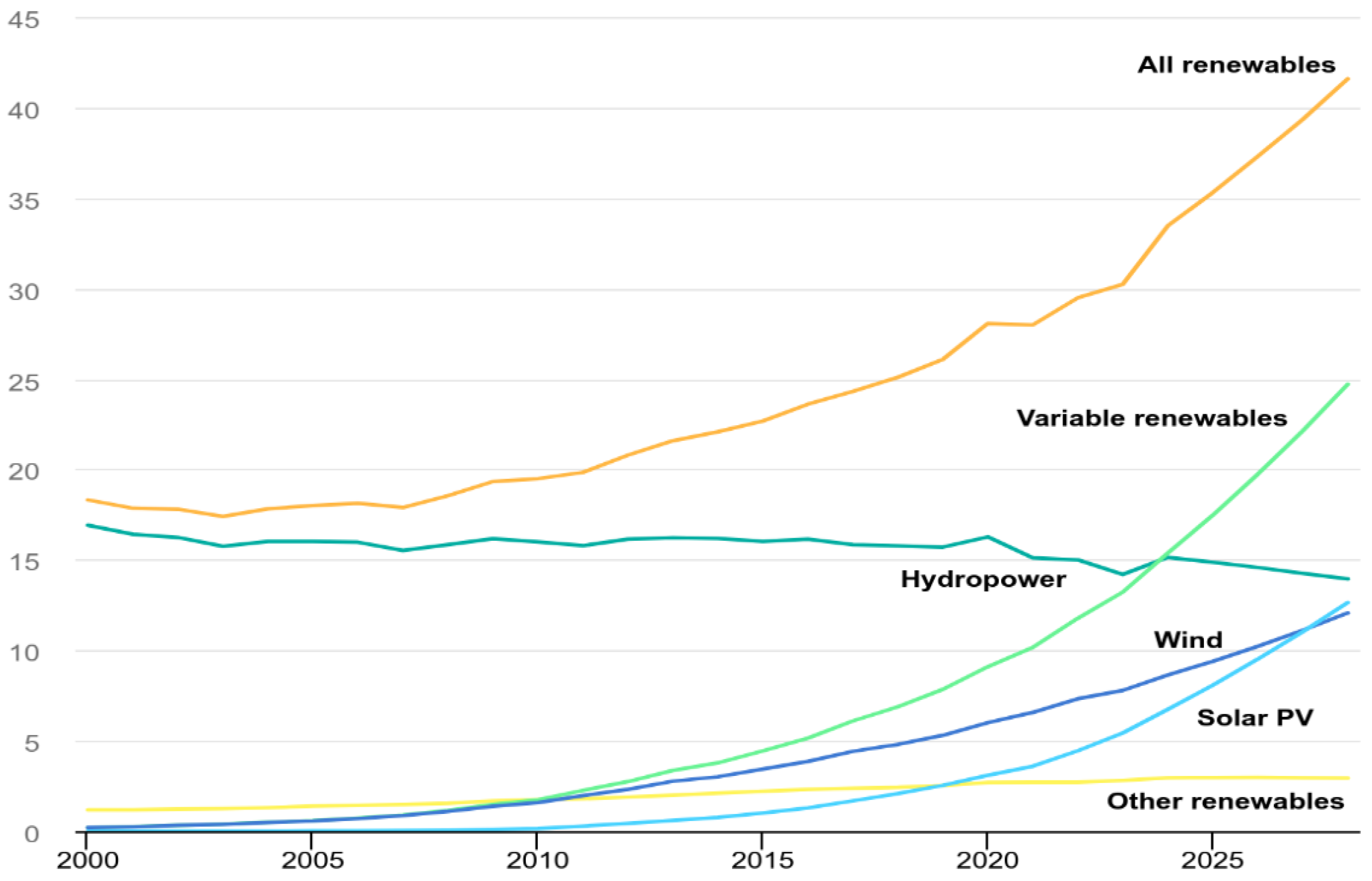
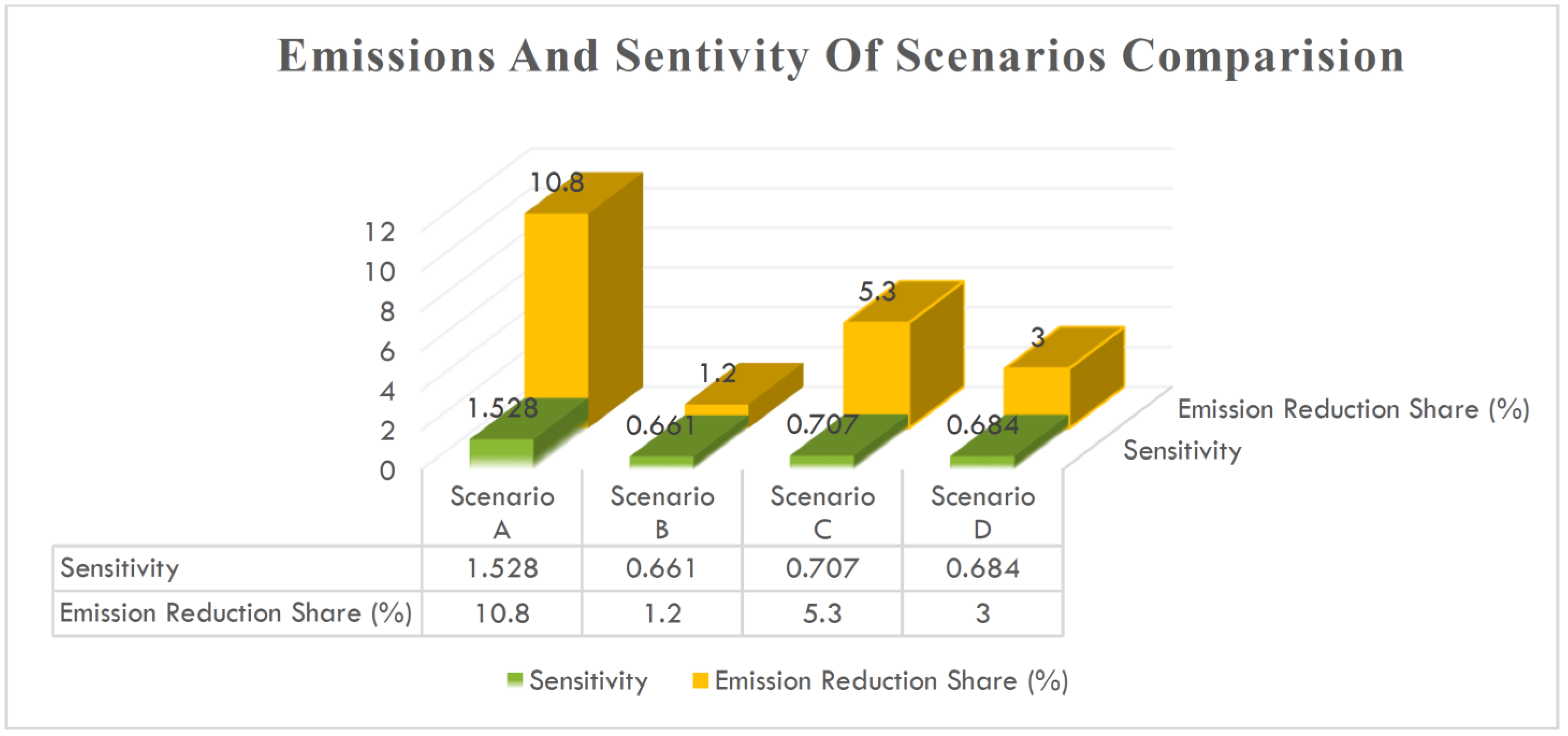
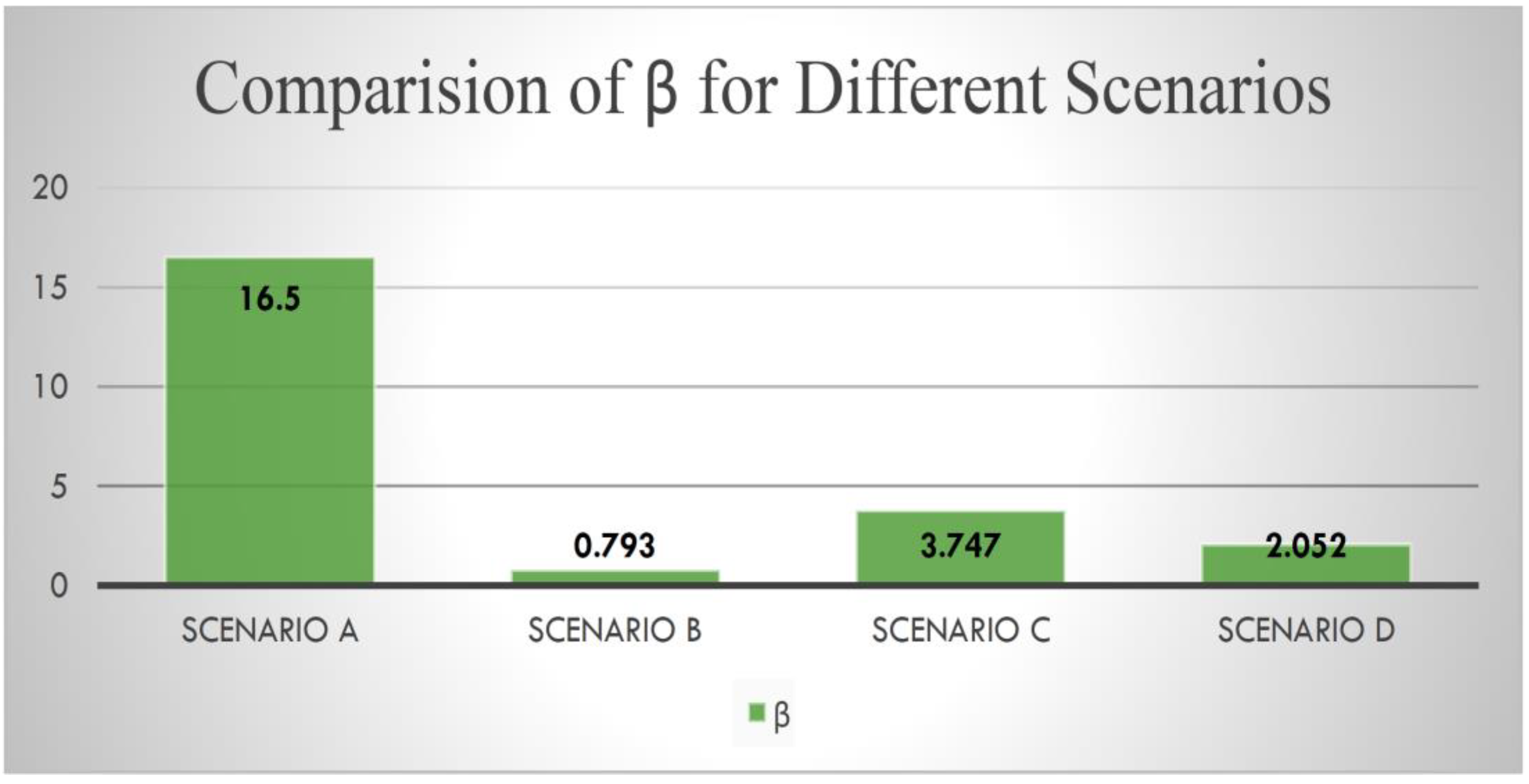
| Emission Source | EF | Fuel Cons (kWh) | Electricity Cons (kWh) | Commuters Calculation Factor | Emissions (kg) | |
|---|---|---|---|---|---|---|
| SCOPE 1 | Emissions associated with diesel fuel | 2.703 kg CO2eq/L | 336,702.42 | - | - | 89,677.43 |
| Emissions associated with gasoline | 2.196 kg CO2eq/L | 239,985.75 | - | - | 55,787.18 | |
| Emissions associated with gas consumption (natural gas) | 0.202 kg CO2eq/kWh | 74,925 | - | - | 15,134.85 | |
| SCOPE 2 | APV building lighting + power | 0.2829 kg CO2eq/kWh | - | 3,309,969.53 | - | 936,390.4 |
| APV roadway lighting | - | 2,493,451.62 | - | 705,397.5 | ||
| APV building: air conditioning system | - | 1,750,656.82 | - | 495,260.8 | ||
| Other consumption | - | 1,320,876 | - | 373,675.8 | ||
| SCOPE 3 | Commercial service-oriented electricity | 0.282 kg CO2eq/kWh | 52,895,613 | - | - | 14,916,563 |
| Service-oriented electricity | 1,420,833 | - | - | 400,674.9 | ||
| Other electricity | 1,814,322 | - | - | 511,638.8 | ||
| Group A (Scope 3) | 0.27 kg CO2eq/kWh | 76,978,166 | - | - | 20,784,105 | |
| Group B—commercial operations (Scope 3) | 121,392,432 | - | - | 32,775,957 | ||
| Group B—service-oriented (Scope 3) | 5,523,956.8 | - | - | 1,491,468 | ||
| Container carrier ship (maritime traffic) | 0.673 kg CO2eq/kWh | 88,305,890 | - | - | 59,429,864 | |
| Cruise ships (maritime traffic) | 0.75 kg CO2eq/kWh | 3,077,724.6 | - | - | 2,308,293 | |
| Ro-Ro and ferries (maritime traffic) | 0.721 kg CO2eq/kWh | 6,769,347.9 | - | - | 4,880,700 | |
| Other ships (tankers, bulk carriers, general cargo carriers) (maritime traffic) | 0.686 kg CO2eq/kWh | 21,071,067 | - | - | 14,454,752 | |
| Auxiliary tugs (maritime traffic) | 0.271 kg CO2eq/kWh | 36,305,933 | - | - | 9,838,908 | |
| Commuters’ emissions | 2.196 kg CO2eq/L | - | - | 170,592.24 | 374,620.6 | |
| Total Emissions | 164,838,868.2 | |||||
| Description | Value |
|---|---|
| Total GHG emissions in tons of CO2eq | 164,838.86 |
| Total volume of goods traffic of the Port of Valencia in tons | 64,361,045 |
| Carbon footprint (Kg of CO2eq/tons of transported goods) | 2.56 |
| Carbon Footprint (t of CO2eq/tons of transported goods) | 0.00256 |
| Emission Source | EF (kg CO2eq/kWh) | Fuel Cons (kWh) | Electricity Cons (kWh) | Emissions (Kg) | |
|---|---|---|---|---|---|
| SCOPE 1 | 160,599.46 | ||||
| SCOPE 2 | APV building lighting + power, APV roadway lighting, APV building: air conditioning system and other consumption | 0.2829 | - | 0 | 0 |
| SCOPE 3 | Commercial service-oriented electricity | 0.282 | 52,895,613 | - | 14,916,562.87 |
| Service-oriented electricity | 1,420,833 | 400,674.906 | |||
| Other electricity | 1,814,322 | 511,638.804 | |||
| Other than electricity operation issues (Group A to commuters’ emissions) | 146,849,306.4 | ||||
| Total Emissions | 162,838,782.44 | ||||
| Emission Source | EF (kg CO2eq/kWh) | Fuel Cons (kWh) | Electricity Cons (kWh) | Emissions (Kg) | |
|---|---|---|---|---|---|
| SCOPE 1 | 160,599.46 | ||||
| SCOPE 2 | APV building lighting + power | 0.2829 | - | 1,654,984.65 | 468,195.15 |
| APV roadway lighting | 1,246,725.81 | 352,698.73 | |||
| APV building: air conditioning system | 875,328.41 | 247,630.4 | |||
| Other consumption | 660,438 | 186,837.9 | |||
| SCOPE 3 | Commercial service-oriented electricity | 0.282 | 26,447,806.5 | - | 7,458,281.43 |
| Service-oriented electricity | 710,416.5 | 200,337.45 | |||
| Other electricity | 907,161 | 255,819.40 | |||
| Other than electricity operation issues (Group A to commuters’ emissions) | 146,849,306.4 | ||||
| Total Emissions | 156,179,707.32 | ||||
| Emission Source | EF (kg CO2eq/kWh) | Fuel Cons (kWh) | Electricity Cons (kWh) | Emissions (Kg) | |
|---|---|---|---|---|---|
| SCOPE 1 | 160,599.46 | ||||
| SCOPE 2 | APV building lighting + power | 0.2829 | - | 2,316,978.67 | 655,473.26 |
| APV roadway lighting | 1,745,416.13 | 493,778.22 | |||
| APV building: air conditioning system | 1,225,459.77 | 346,682.56 | |||
| Other consumption | 924,613.2 | 261,573.07 | |||
| SCOPE 3 | Commercial service-oriented electricity | 0.282 | 37,026,929 | - | 10,441,593.97 |
| Service-oriented electricity | 994,583 | 280,472.4 | |||
| Other electricity | 1,270,025.4 | 358,147.16 | |||
| Other than electricity operation issues (Group A to commuters’ emissions) | 146,849,306.4 | ||||
| Total Emissions | 159,847,626.5 | ||||
Disclaimer/Publisher’s Note: The statements, opinions and data contained in all publications are solely those of the individual author(s) and contributor(s) and not of MDPI and/or the editor(s). MDPI and/or the editor(s) disclaim responsibility for any injury to people or property resulting from any ideas, methods, instructions or products referred to in the content. |
© 2024 by the authors. Licensee MDPI, Basel, Switzerland. This article is an open access article distributed under the terms and conditions of the Creative Commons Attribution (CC BY) license (https://creativecommons.org/licenses/by/4.0/).
Share and Cite
Issa-Zadeh, S.B.; Esteban, M.D.; López-Gutiérrez, J.-S.; Garay-Rondero, C.L. Unveiling the Sensitivity Analysis of Port Carbon Footprint via Power Alternative Scenarios: A Deep Dive into the Valencia Port Case Study. J. Mar. Sci. Eng. 2024, 12, 1290. https://doi.org/10.3390/jmse12081290
Issa-Zadeh SB, Esteban MD, López-Gutiérrez J-S, Garay-Rondero CL. Unveiling the Sensitivity Analysis of Port Carbon Footprint via Power Alternative Scenarios: A Deep Dive into the Valencia Port Case Study. Journal of Marine Science and Engineering. 2024; 12(8):1290. https://doi.org/10.3390/jmse12081290
Chicago/Turabian StyleIssa-Zadeh, Seyed Behbood, M. Dolores Esteban, José-Santos López-Gutiérrez, and Claudia Lizette Garay-Rondero. 2024. "Unveiling the Sensitivity Analysis of Port Carbon Footprint via Power Alternative Scenarios: A Deep Dive into the Valencia Port Case Study" Journal of Marine Science and Engineering 12, no. 8: 1290. https://doi.org/10.3390/jmse12081290






